Designing for High-Traffic Outdoor Spaces
Flexible Concrete Mats
Flexible concrete mats can provide vehicular parking for high-traffic outdoor areas. The flexible concrete mats provide designers with the option to green up an outdoor space by adding vegetation to the interior openings in the mat. The mats are made of wet-cast, low-moisture-absorption concrete, which is cast with holes to allow for infiltration and root penetration of the infill vegetation material. Cast inside the concrete is an engineered polymer grid that provides flexibility to the concrete mat. This flexibility provides added tensile strength to complement the compressive strength of the concrete. The flexibility also allows these mats to conform to irregular ground surfaces along pre-defined linear grooves while providing structural support for high-traffic use. The flexible concrete mat maintains its load-supporting characteristics even when saturated. The design also eliminates sharp edges and won't crack and break like rigid concrete or pop up like plastic. The small openings in the concrete grid provide spaces for infill planting of turf grass or groundcovers as well as infill with gravel, sand, or crushed stone.
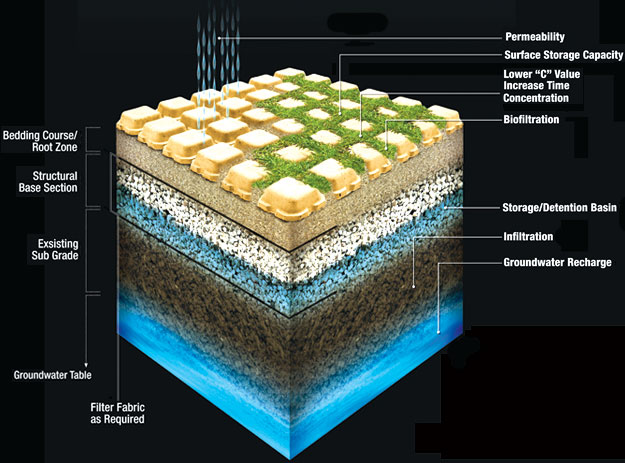
Photo courtesy of Soil Retention
This image shows the porous composition of a flexible concrete mat.
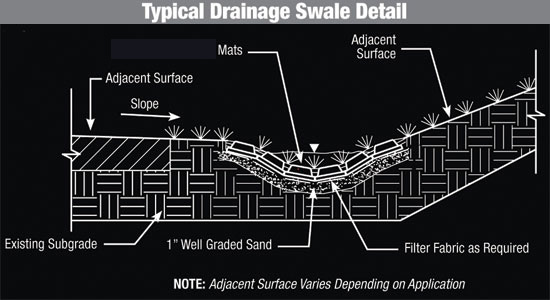
The mat is designed so that the grass or groundcover that is planted in the holes can develop a continuous root system below the mat surface, thus promoting a healthy turf while minimizing moisture evaporation. Because the flexible concrete mat has porous openings and a shallow depth, it allows water to flow through laterally and to penetrate the root system of the grass. In addition, the geometry of the mat limits infill and root compaction by concentrating the load on the concrete pads instead of void spaces. The large bearing connections of the concrete coupled with the size of the holes or void spaces provide the optimal situation for sustaining and maintaining grass or other groundcover materials.
Many urban sites with large paved surfaces are challenged in trying to obtain LEED® and SITES credits. LEED® NC Criteria SSc6.2 provides credits for Stormwater Design – Quality Control. Credits are given to projects that address polluted runoff. The credit measures the Total Suspended Solids (TSS) as the indicator of level of pollution and the design must be able to show that the stormwater treatment system is effective at treating all rainstorms for any year up to 90 percent of the average annual rainfall. The American Society of Landscape Architects in conjunction with the National Arboretum and the Lady Bird Johnson Wildflower Center has issued their Sustainable SITES Initiative rating system. Section 3 – Site Design Water provides a possible 23 credits for designs that manage and reduce stormwater at the site.
For high-traffic areas that must meet the requirements of LEED®, SITES™, or International Green Construction Code (IGCC) criteria, the flexible concrete mat can assist in stormwater management, reduce heat island effect, lower run-off coefficients, assist in on-site water storage and biofiltration, and contribute to groundwater recharge.
The mats can be used in place of concrete or asphalt pavement, thus providing alternative solutions to stormwater management by providing surface areas for biofiltration, infiltration, and water storage below the parking/driving surface without requiring the loss of valuable site area to surface bioswales or detention basins. An example of this type of use is the fire lane at a Kaiser Permanente Hospital. The total surface area of flexible concrete mats can contribute towards required green space allowances and also meet criteria for reducing Heat Island Effect.
A project in Hastings on Hudson, New York, features three different residences on a shared lot just across from a walking trail. An area was needed for off-street parking for up to seven vehicles. The Planning Board wanted to be assured that whatever was used to create the unique, diagonally shaped parking space would blend well with the natural surroundings and not distract from the nearby Aqueduct Trailway. Ned Baldwin, senior partner with the firm of Baldwin & Franklin Architects, proposed the use of flexible concrete mats to create an area of drivable grass. “By using drivable grass instead of asphalt paving, we easily gained the approval of the Planning Board,” says Baldwin. “The grass we planted over it turned green in less than three weeks, which was very encouraging, but the winter was the most severe we've had in 15 years with as much as 30 inches of snowfall at one time. Despite that terrible winter so soon after its installation, it continues to thrive.”
Flexible concrete mats are manufactured to meet ASTM precast concrete standards for compressive strength, standard proctor, particle size analysis, concrete aggregates, mixed concrete, Portland cement, blended hydraulic cement, slump flow and pigments for integrally colored concrete. The manufacture process for the flexible concrete mats also follows the American Concrete Institute (ACI) standard practice for selecting proportions for normal, heavy weight, and mass concrete, and for durability.
Flexible concrete mats can be used in all climate areas, but specific recommendations are provided for cold weather applications. Specifications recommend that sites requiring the use of snowplow machinery install mow curb strips prior to installation of the paving mats and that the mats should be depressed ½ inch below the top of the mow curb/strip to protect the mat from the snowplow blade. In addition, it is recommended that snowplow equipment operators be educated about the underlying surface prior to snow removal and that the snowplow equipment be fitted with Teflon runners to prevent damage to the mat.
Durable Wood Walking Surfaces
Modular wood tiles can provide another option for high-traffic areas which require durable and sustainable walking surfaces. Because of their modular characteristic and design flexibility, modular wood tiles can be installed over a variety of surfaces and are adaptable to a variety of sites. Modular wood tiles can be used to create large wood deck surfaces either on building rooftops or at ground-level surfaces. At the ground level, these modular decks have served as outdoor dining areas for high-traffic restaurants and as pop-up parks.
Pop-up parks or parklets have been designed and built throughout the United States in areas of varying climate such as New York, California, Minnesota, and Colorado. Modular wood tiles were used in the first-ever pop-up park in the country at the Mojo Café in San Francisco, California. The pop-up park has been in use since 2010 and repurposed street space for people rather than cars. The parklet, which takes up space formally occupied by two parked vehicles, provides several hundred square feet of benches, tables, planters, and bike racks. The pilot program in San Francisco was a huge success and increased sales at a local café by 20 percent. As a result, additional employees were hired. The success of this program led the way for dozens of similar projects across the city, making livable streets possible all over the United States.
Studies have been done to evaluate the function and durability of pop-up parks using modular wood tiles. The studies show an emerging trend among communities throughout the country with a desire to make use of small urban spaces that are traditionally unbuildable. Modular wood tiles enable greater design creativity in small urban spaces.
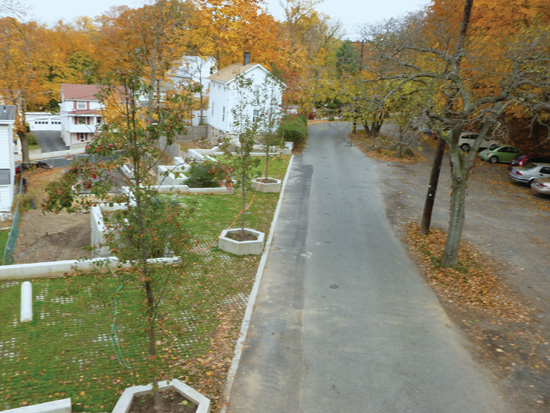
Photo courtesy of Soil Retention
The use of flexible concrete mats creates a drivable grass area in Hastings on Hudson, New York.
Modular wood deck tiles are FSC® certified (FSC-C13454) so Ipe and Massarunduba wood tiles could contribute LEED points under Materials and Resources Credit 7 (MR Credit 6 for CS). The wood tiles are supported by pedestals, which contain 20 percent post-industrial recycled material, thus potentially contributing to multiple points within Materials and Resources Credits 4 as a single product contributing to multiple LEED points. The tiles are made from wood remnants. These remnants are premium-grade shorts purchased from the flooring and furniture industries that comply with strict regulations regarding extraction, milling, and transport.
Modular wood tiles come in 2 foot by 2 foot (2 x 2) and 2 foot by 4 foot (2 x 4) sized units. Each modular tile has seven to eight top slats and three bottom slats that are held together with 48 stainless steel screws that are inserted from the bottom so that the fasteners are not visible on the surface. The wood tiles are integrated with a pedestal system with tabs which hold the wood tile units in place. A fastening kit adds further stability with the system. The pedestal system has a levelling capacity that compensates for slope and changes in grade. Through this levelling system, elevations can be adjusted from heights as little as 1/8 of an inch up to 36 inches with pedestal attachments.
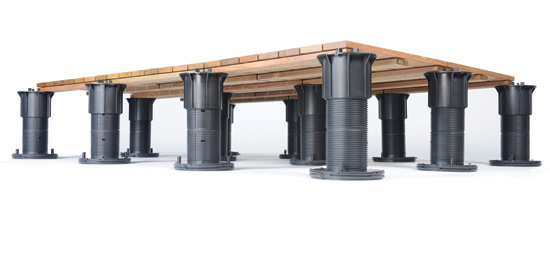
Photo courtesy of Bison Innovative Products
Modular wood tiles supported by HDP pedestals
The wood tiles are ADA compliant as the surface texture and spacing between the units meet ADA criteria. The wood tiles meet industry standards and certifications for wind uplift, fire rating, slip resistance, weight-bearing capacity, and seismic. To ensure adequate weight bearing in support of heavier loads, it is recommended that more pedestals be used above the standard 1.2 ratio of pedestals to wood tiles. With respect to seismic and uplift requirements, the pedestal systems can include stabilizing bracing in addition to fasteners which deter wind uplift.
Notice

www.aal.net

www.bisonip.com

www.kimlighting.com

www.soilretention.com/drivable-grass

www.StressCreteGroup.com
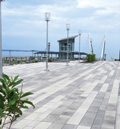
commercial.unilock.com

tournesolsiteworks.com/product-twig-bench.html









